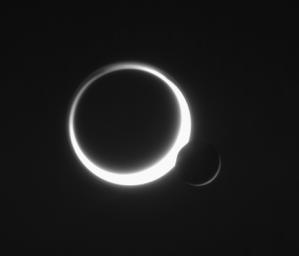
|
Titan’s Kiss
- Click the image above for a larger view
- Full-Res JPEG (463 x 397) (5.8 kB)
- Full-Res TIFF (463 x 397) (184.2 kB)
Caption:
Saturn's two largest moons meet in the sky in a rare embrace. Smog-enshrouded Titan (5,150 kilometers, or 3,200 miles across) glows to the left of airless Rhea (1,528 kilometers, or 949 miles across).
The image was taken in visible light with the Cassini spacecraft narrow-angle camera on June 11, 2006 at a distance of approximately 3.6 million kilometers (2.2 million miles) from Rhea and 5.3 million kilometers (3.3 million miles) from Titan. The Sun-Rhea-spacecraft, or phase, angle is 157 degrees on Rhea. Image scale is 22 kilometers (13 miles) per pixel on Rhea and 32 kilometers (20 miles) per pixel on Titan.
Background Info:
The Cassini-Huygens mission is a cooperative project of NASA, the European Space Agency and the Italian Space Agency. The Jet Propulsion Laboratory, a division of the California Institute of Technology in Pasadena, manages the mission for NASA's Science Mission Directorate, Washington, D.C. The Cassini orbiter and its two onboard cameras were designed, developed and assembled at JPL. The imaging operations center is based at the Space Science Institute in Boulder, Colo.
For more information about the Cassini-Huygens mission visit http://saturn.jpl.nasa.gov/home/index.cfm . The Cassini imaging team homepage is at http://ciclops.org .
Cataloging Keywords:
| Name | Value | Additional Values |
|---|---|---|
| Target | Titan | Rhea |
| System | Saturn | |
| Target Type | Satellite | |
| Mission | Cassini-Huygens | |
| Instrument Host | Cassini Orbiter | |
| Host Type | Orbiter | |
| Instrument | Imaging Science Subsystem (ISS) | |
| Detector | Narrow Angle Camera | |
| Extra Keywords | Grayscale, Visual | |
| Acquisition Date | ||
| Release Date | 2006-07-14 | |
| Date in Caption | 2006-06-11 | |
| Image Credit | NASA/JPL/Space Science Institute | |
| Source | photojournal.jpl.nasa.gov/catalog/PIA08221 | |
| Identifier | PIA08221 | |
